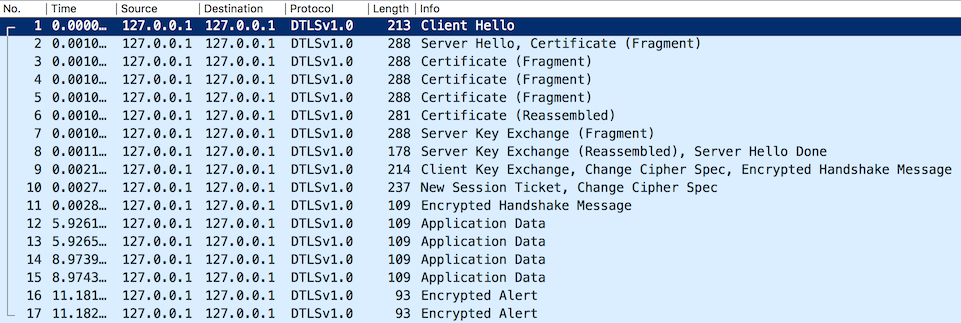While recently trying to implement a DTLS protocol in Tokio, I ran into some friction:
- Using DTLS (Datagram TLS, i.e. TLS over UDP) in Tokio is not well documented, and I couldn't find a clear example.
- The
native-tlscrate, which provides a platform-independent API to your system's local TLS library (e.g. OpenSSL, Mac OS security-framework, or Windows SChannel), does not currently support DTLS. - By extension, the
tokio-tlscrate, which relies onnative-tls, also does not support DTLS. (See this old issue.)
OpenSSL itself supports DTLS, of course. If you are willing to have a
dependency on OpenSSL, this is always an option. The Rust
openssl crate supports all of the
OpenSSL API required for DTLS.
The final piece of the puzzle is Alex Crichton's
tokio-openssl crate, which
is small in size but big on the magic needed to use OpenSSL from Tokio.
This repository provides a simple program implementing a DTLS client and server. The client forwards lines from standard input to the peer, and prints data from the peer to standard output. The server echos each line back to the client with "Echo: " prepended.
While UDP itself is connectionless, DTLS effectively adds a connection
layer -- state must be kept in the server for each "connected" peer.
Using UDP in Tokio to implement a stateful server seems to require a bit
of extra plumbing at this time. My solution was to implement a
UdpServer stream which manages the actual UDP socket, and dispatches
incoming datagrams to child streams which are handled individually by
each DTLS session.
To run the server, use the "server" command-line argument followed by the host and port of the local socket address for binding:
cargo run -- server 127.0.0.1:9000
For more feedback on what the server is doing, you can turn on logging
via the RUST_LOG environment variable:
RUST_LOG="tokio_dtls_example=debug" cargo run -- server 127.0.0.1:9000
To run the client, use the "client" command-line argument followed by the destination host and port separated by a colon:
cargo run -- client 127.0.0.1:9000
If the client has successfully connected to the server, you can type lines of text and see them echoed back to you:
You say goodbye
Echo: You say goodbye
I say hello
Echo: I say hello
When you close the input (e.g. by typing Ctrl-D on Mac or Linux), the
DTLS session should be properly shut down by each side issuing a TLS
close_notify alert.
If you use a tool like Wireshark, you should be able to see that communication is encrypted in TLS records rather than being sent in plaintext:
To verify operation independently of this program, you can use the OpenSSL command-line tool to connect to the server:
openssl s_client -dtls1 -connect 127.0.0.1:9000
As far as I can tell, this is a functioning example of DTLS. Please let me know if you discover any faults.
This crate is distributed under the terms of both the MIT license and the Apache License (Version 2.0). See LICENSE-MIT and LICENSE-APACHE for details.
Unless you explicitly state otherwise, any contribution you intentionally submit for inclusion in the work, as defined in the Apache-2.0 license, shall be dual-licensed as above, without any additional terms or conditions.
